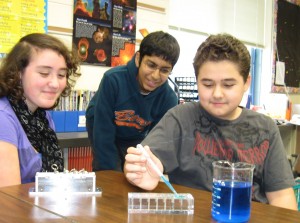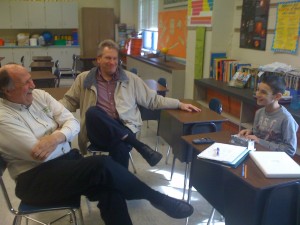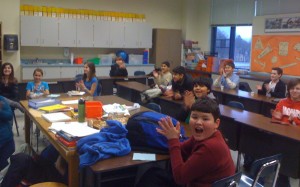STEM Education and Our Experience in STS-134
We have seen exciting developments with our participation in the Student Spaceflight Experiments Program in terms not only of inspiring students to consider math, science, engineering, and technology as possible career fields (well for some students, definite career fields at this point!) but also in terms of engaging students in truly open ended problem solving and experimental design, in terms of offering real STEM opportunities where the projects really incorporated every aspect of truly great STEM education, in terms of building remarkable relationships with mentors in exciting fields of science, and in terms of helping teachers to break down real world problems into manageable parts for students to solve themselves.
The SSEP project has inspired students in our district to be excited about STEM activities and to monitor the news for developments in these fields. Students worked tirelessly to develop their experiment plans and worked after school and on a day off to improve their work. They were motivated to persevere when problems arose and said that the work was difficult but worth it. A 6th grader was heard to exclaim how incredibly “cool” it was to solve a difficult math calculation to predict the results of an experiment on microencapsulation. A 7th grader was so inspired and excited by her SSEP experience that she pushed to be allowed to visit the high school’s new independent research STEM lab class to see what she might be able to do in the future, and she will take a biotechnology class this summer. These are a few examples of the remarkable effects that the SSEP program is having on our students.
 The SSEP opportunity really is about an open-ended experimental design challenge that not only incorporates science and math skills, but also requires students to answer their question using the limitations of an apparatus that can fly on the space shuttle, and a sample size that caused students and teachers to stare wide-eyed at the 0.125 cubic centimeter experiment slot. Students vowed to engineer a better apparatus to carry experiments into space and then pondered ways to make their experiment fit in the 0.125 cubic centimeters. What an amazing integration of all the STEM disciplines in the manner that we should be striving for in the classroom. Teachers work in their separate fields, but if our next generation is to succeed, we need students to have very integrated experiences in the STEM fields in their classrooms. Our SSEP experience has opened our eyes to the possibilities that may exist for new ways to give our students integrated STEM problems to solve.
The SSEP opportunity really is about an open-ended experimental design challenge that not only incorporates science and math skills, but also requires students to answer their question using the limitations of an apparatus that can fly on the space shuttle, and a sample size that caused students and teachers to stare wide-eyed at the 0.125 cubic centimeter experiment slot. Students vowed to engineer a better apparatus to carry experiments into space and then pondered ways to make their experiment fit in the 0.125 cubic centimeters. What an amazing integration of all the STEM disciplines in the manner that we should be striving for in the classroom. Teachers work in their separate fields, but if our next generation is to succeed, we need students to have very integrated experiences in the STEM fields in their classrooms. Our SSEP experience has opened our eyes to the possibilities that may exist for new ways to give our students integrated STEM problems to solve.
 During our participation in SSEP, we reached out to mentors in many fields of science. The inspiration of SSEP and helping students to put an experiment in space opened doors to us that otherwise would not have been opened. There were very special individuals in the scientific community who were so inspired by the opportunity to help students conduct real experiments that would orbit the planet that they gladly made their time, wealth of talents, and resources available to our students. Students had coast to coast conference calls with stem cell scientists and developers. They had the direct line to the founder of a company that deals with microencapsulation and have access to using the equipment at that facility. The mentors taught lessons in real science such as the limits of an experiment can cause you to need to rethink what is possible under current restraints. They taught students how to do thought experiments with math to predict expected results. This experience with SSEP has enriched, influenced, and altered for the better the lives of our students.
During our participation in SSEP, we reached out to mentors in many fields of science. The inspiration of SSEP and helping students to put an experiment in space opened doors to us that otherwise would not have been opened. There were very special individuals in the scientific community who were so inspired by the opportunity to help students conduct real experiments that would orbit the planet that they gladly made their time, wealth of talents, and resources available to our students. Students had coast to coast conference calls with stem cell scientists and developers. They had the direct line to the founder of a company that deals with microencapsulation and have access to using the equipment at that facility. The mentors taught lessons in real science such as the limits of an experiment can cause you to need to rethink what is possible under current restraints. They taught students how to do thought experiments with math to predict expected results. This experience with SSEP has enriched, influenced, and altered for the better the lives of our students.
And it was not just the students who learned from the mentors. Teachers learned first hand how scientists think and how they approach problems in current fields of study. We learned how to break down big unwieldy problems into small parts for the students to work on, because the mentors who said yes to helping our students with SSEP were REALLY good at helping the students frame their own questions and look for their own answers. So as the students developed their experiment plans with mentors we learned new ways to think about teaching students experimental design! More such relationships and lessons would serve to further enhance the faculty’s ability to train the next generation of scientists.
The SSEP experience is like none other that we have ever participated in and offers all of the essential qualities of excellent science teaching prevalent in the literature today such as the integration of science, technology, engineering, and math, engagement of the community and mentors to help train the next generation of scientists, and the notion that everyone can engage in scientific endeavors to answer questions and marvel at possibilities, not just people in lab coats mixing chemicals. We engaged every student in our district, from Pre-K through 8th grade, in the excitement of this unique and enriching SSEP experience and science teaching in our district will be altered for the better for this amazing opportunity.





